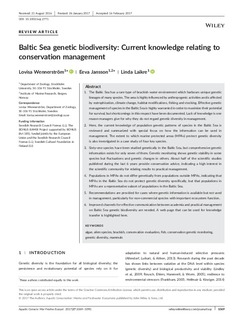| dc.description.abstract | 1. The Baltic Sea has a rare type of brackish water environment which harbours unique genetic lineages of many species. The area is highly influenced by anthropogenic activities and is affected by eutrophication, climate change, habitat modifications, fishing and stocking. Effective genetic management of species in the Baltic Sea is highly warranted in order to maximize their potential for survival, but shortcomings in this respect have been documented. Lack of knowledge is one reason managers give for why they do not regard genetic diversity in management.
2. Here, the current knowledge of population genetic patterns of species in the Baltic Sea is reviewed and summarized with special focus on how the information can be used in management. The extent to which marine protected areas (MPAs) protect genetic diversity is also investigated in a case study of four key species.
3. Sixty‐one species have been studied genetically in the Baltic Sea, but comprehensive genetic information exists for only seven of them. Genetic monitoring shows genetic stability in some species but fluctuations and genetic changes in others. About half of the scientific studies published during the last 6 years provide conservation advice, indicating a high interest in the scientific community for relating results to practical management.
4. Populations in MPAs do not differ genetically from populations outside MPAs, indicating that MPAs in the Baltic Sea do not protect genetic diversity specifically, but that populations in MPAs are a representative subset of populations in the Baltic Sea.
5. Recommendations are provided for cases where genetic information is available but not used in management, particularly for non‐commercial species with important ecosystem function.
6. Improved channels for effective communication between academia and practical management on Baltic Sea genetic biodiversity are needed. A web page that can be used for knowledge transfer is highlighted here. | nb_NO |
